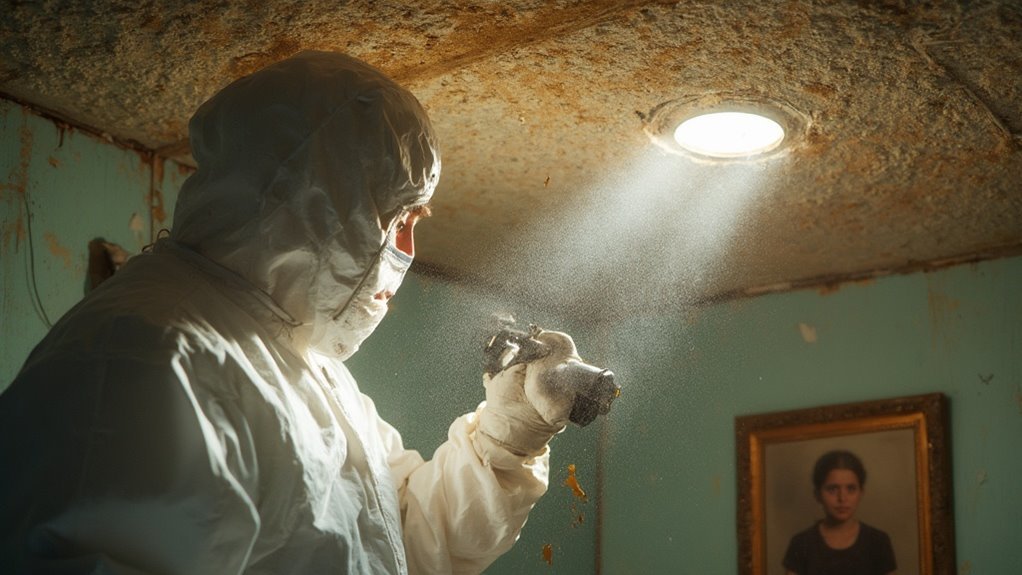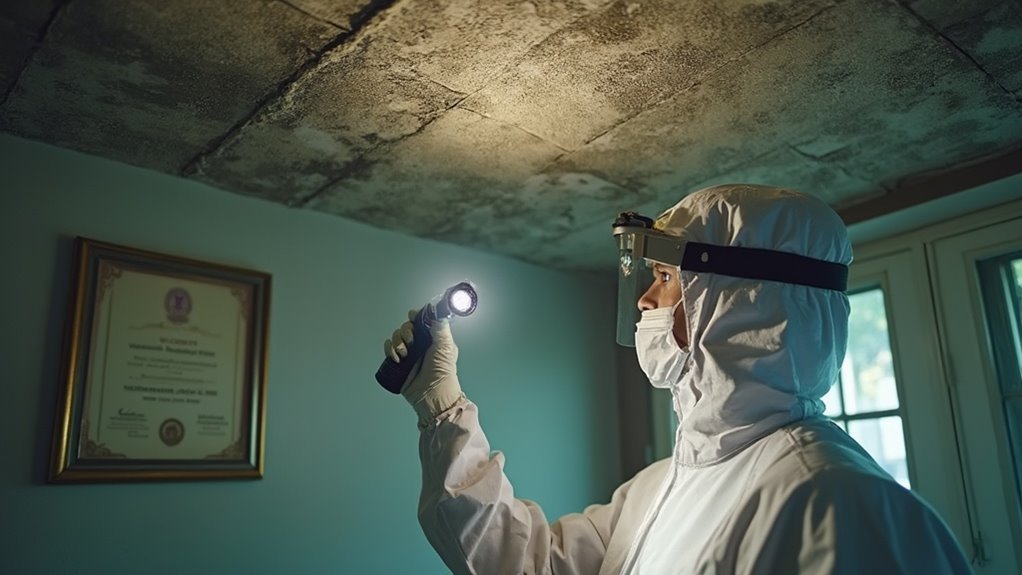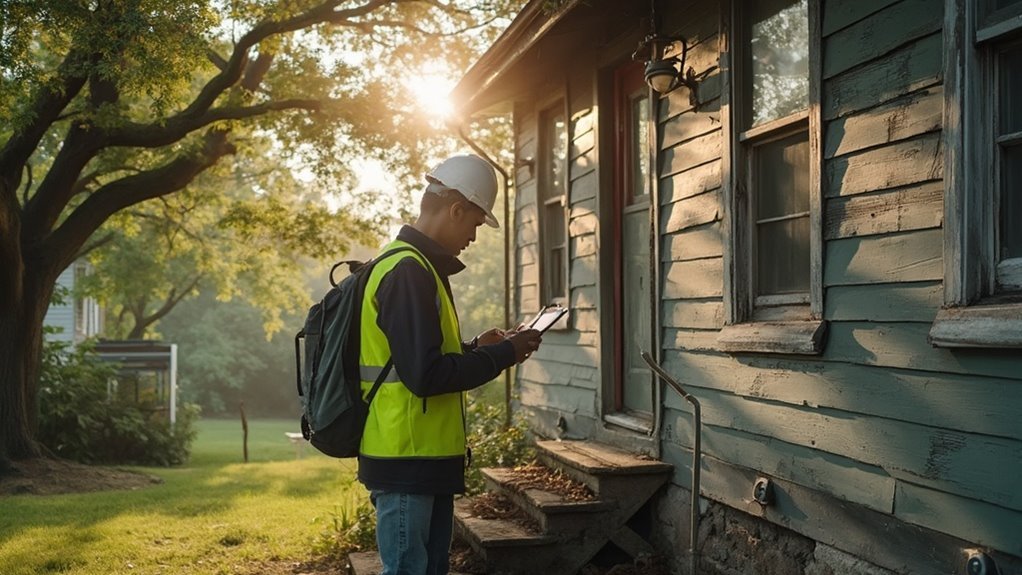An asbestos inspection is essential for your safety and financial well-being. It helps identify harmful materials, protecting you from serious health risks linked to asbestos exposure, such as lung cancer and mesothelioma. Economically, early detection can save you money by avoiding costly health expenses and maintaining your property's value. It additionally guarantees compliance with legal regulations, preventing expensive penalties. Furthermore, inspections provide peace of mind, knowing that your environment is safe. By understanding these benefits, you empower yourself with knowledge to make educated choices about your property and health. Uncover more advantages that an asbestos inspection offers.
Health Risk Mitigation

Asbestos inspection plays a vital role in health risk mitigation, especially given the severe consequences of exposure to this hazardous material. Understanding asbestos awareness is important for guaranteeing your safety and the well-being of those around you. Exposure to asbestos can lead to debilitating diseases, including lung cancer and mesothelioma, often surfacing years after initial contact. Since there's no safe level of exposure, conducting thorough inspections becomes necessary.
Identifying asbestos early allows for immediate action to minimize health risks. By utilizing certified inspectors and specialized equipment, you can make certain that all asbestos-containing materials are identified and managed properly. Regular monitoring and extensive surveys help maintain a safe environment and protect against potential respiratory diseases like asbestosis. Conducting an asbestos survey is essential before any renovation or demolition work to ensure compliance with safety regulations. Additionally, homes built before 1980 often have a higher risk of containing asbestos, necessitating careful inspection.
Implementing health protection measures, such as using personal protective equipment (PPE), further improves safety during inspections. In addition, compliance with OSHA and EPA guidelines not only safeguards your health but also avoids penalties for noncompliance. Ultimately, the health benefits of proactive asbestos management can't be overstated. By taking these steps, you actively reduce the risk of serious health issues and create a safer living or working space for everyone involved.
Economic Advantages
Addressing health risks through asbestos inspection not only protects well-being but furthermore offers considerable economic advantages. By identifying asbestos issues early, you can achieve notable cost reduction. Ignoring these problems often leads to escalating health-related expenses and potential litigation, which can strain your finances. Preventive measures, like testing and removal, minimize hidden costs such as fines for non-compliance and health complications.
Moreover, early detection can lower the costs associated with asbestos removal, especially compared to uncovering it during renovations or demolitions. Bundling asbestos testing with other home inspections can further reduce your expenses. Additionally, proper compliance with safety regulations ensures that you avoid hefty fines and legal actions that could arise from neglecting asbestos issues.
On the investment protection front, conducting an asbestos survey can greatly improve your property's resale value. It assures potential buyers that any issues have been properly addressed, thereby reducing market risk and safeguarding your investment. Continuous operations are also essential; addressing asbestos proactively prevents costly business interruptions and legal complications.
Legal Compliance Necessities

When you undertake a renovation or demolition project, understanding the legal compliance necessities surrounding asbestos inspections is essential. Familiarizing yourself with regulatory requirements, the permit acquisition process, and potential legal liabilities can save you from costly penalties and guarantee the safety of all involved. By prioritizing these aspects, you not only adhere to the law but likewise protect your investment and reputation.
Regulatory Requirements Overview
Understanding regulatory requirements for asbestos inspections is vital for guaranteeing legal compliance and protecting public health. The Environmental Protection Agency (EPA) enforces the Asbestos National Emission Standards for Hazardous Air Pollutants (NESHAP), which governs how asbestos is handled, particularly during renovation and demolition activities. To remain compliant, you must adhere to 40 CFR sections 61.140 through 61.157, along with relevant state regulations.
Asbestos surveys are required to comply with both federal and state laws to prevent asbestos disturbance. This includes having them performed by Cal/OSHA Certified Asbestos Consultants (CACs), who are authorized to prepare and sign Asbestos Survey Reports. It's vital to guarantee contractors are informed about Asbestos-Containing Materials (ACMs) and receive appropriate training for safe handling.
Your compliance assessment should focus on thorough site inspections and detailed reporting, which includes contamination assessments, recommendations for remedial actions, and necessary documentation like sample chains of custody. Regularly reviewing regulatory updates will help you stay informed and maintain compliance, ultimately safeguarding both public health and your legal standing in asbestos management.
Permit Acquisition Process
Obtaining the necessary permits for asbestos abatement is a critical step in guaranteeing legal compliance and safe project execution. You'll need to navigate various permit types depending on whether your project is residential or commercial. For instance, residential applications require a $200 filing fee, while commercial projects likewise incur a similar fee, plus inspection costs based on square or linear footage, capped at $2,000.
Initiating the application process involves submitting your request through electronic permit processing portals. Be prepared to include detailed construction documents if your abatement requires access to asbestos-containing materials. The application timeline can vary, as the Department of Environmental Protection's Asbestos Technical Review Unit (A-TRU) reviews all submissions and may request additional documentation, such as a Work Place Safety Plan.
Once approved, verify that the permit is prominently posted at your work site. After the abatement, you must file final inspection reports using the A-TR1 form with the DEP and maintain these records for six years. This thorough process not only helps you comply with legal requirements but also guarantees the safety of your work environment.
Legal Liabilities and Risks
Steering through the legal terrain surrounding asbestos management is vital for property owners and contractors alike, as non-compliance can lead to significant liabilities. If you fail to conduct the necessary asbestos surveys before renovation or demolition, you expose yourself to hefty fines and potential litigation exposure. Certified inspectors must perform these surveys, and any improper documentation or misidentification of asbestos can pave the way for legal complications.
Compliance costs can escalate quickly, especially if you're held accountable for breaching warranties on asbestos products or for health risks stemming from misidentified asbestos. Inspectors face liability for inadequate assessments, and companies can incur severe penalties for manufacturing unsafe products.
Moreover, the legal theories of negligence and strict liability often apply in asbestos cases, meaning that even unintentional oversights can result in costly litigation. By investing in professional asbestos inspections, you minimize these risks, safeguard your property, and guarantee compliance with regulations designed to protect public health. Remember, the consequences of non-compliance can be severe, making it imperative to stay informed and proactive in your asbestos management strategy.
Inspection Process Overview
When you immerse yourself in the asbestos inspection process, you'll encounter a systematic approach designed to identify and manage potential asbestos-containing materials in a building. The process begins with a visual inspection and an initial historical review, helping you gather fundamental background information. You'll focus on accessible areas to pinpoint where asbestos might be present.
Inspection techniques vary, but a detailed examination of building materials for damage is significant. During the physical inspection, you'll utilize sampling methods to collect material samples from suspected areas. This sampling is critical for laboratory analysis, guaranteeing that any materials identified are confirmed as containing asbestos. Accredited laboratories employ methods like Polarized Light Microscopy (PLM) and Transmission Electron Microscopy (TEM) for accurate identification.
Once the inspection is complete, you'll document your findings thoroughly. This documentation includes detailed reports outlining your observations and recommendations, which will guide any necessary follow-up actions. The thoroughness of this process not only guarantees safety but provides a clear understanding of any potential risks associated with asbestos exposure in the building.
Effective Management Strategies

To effectively manage asbestos risks, you need to implement proactive risk mitigation strategies and long-term safety planning. This approach guarantees that you address potential hazards before they become significant issues, ultimately protecting occupants and workers. By establishing an all-encompassing management plan, you can maintain a safe environment while complying with regulatory standards.
Proactive Risk Mitigation
Proactive risk mitigation is vital for effectively managing asbestos-related hazards, as it allows you to identify potential issues before they escalate. By prioritizing asbestos awareness and implementing robust risk management strategies, you can greatly improve safety in your environment.
- Thorough inspections lead to early detection of asbestos materials.
- Advanced detection methods, like infrared technology, facilitate precise assessments.
- Continuous monitoring systems provide real-time data on airborne asbestos fibers.
Utilizing thorough inspections conducted by certified professionals helps develop effective abatement plans while guaranteeing compliance with regulatory standards. Advanced detection methods, including AI-based analysis, provide the capability to make timely interventions and reduce exposure risks. Furthermore, continuous monitoring allows for immediate responses to potential hazards, revolutionizing your approach to asbestos management.
Incorporating these proactive strategies not only minimizes risks but also promotes a culture of safety among your team. By taking these steps, you can ascertain that your workplace remains compliant and safe, ultimately protecting both your employees and your organization from the long-term consequences of asbestos exposure.
Long-Term Safety Planning
Long-term safety planning is vital for effective asbestos management, ensuring that your organization is prepared to address potential hazards over time. By conducting thorough surveys, you can identify all asbestos-containing materials (ACMs) within your facilities, allowing for educated decision-making about management strategies based on asbestos longevity. Risk assessments will help you evaluate the condition of ACMs and determine necessary abatement plans, which should outline the scope of work and compliance with safety protocols.
Regular inspections and advanced detection methods, such as AI-based analysis, are fundamental for maintaining a proactive stance. Integrating continuous air-quality monitoring systems provides real-time data, ensuring that you can act promptly to any emerging issues. When removal is necessary, employing wet removal methods and advanced air filtration systems minimizes worker exposure and improves safety.
Documentation is key; keep detailed records of all surveys, inspections, and abatement activities for future reference. By prioritizing thorough training and adhering to strict safety protocols, you'll encourage a culture of safety that protects both your workers and building occupants. Essentially, effective long-term safety planning safeguards your organization against the risks associated with asbestos.
Importance of Awareness
Awareness of asbestos-related health risks is fundamental for safeguarding both individual and public well-being. It's imperative to recognize that exposure to asbestos fibers can lead to severe health issues, including lung cancer and mesothelioma. Given the long latency period of these diseases, early detection is crucial.
- Short-term exposure can still pose considerable health risks.
- Individuals with existing lung conditions face heightened vulnerability.
- Workers in construction and demolition are particularly at risk.
This is where asbestos education plays a significant role. By promoting community awareness, you empower individuals to understand the dangers associated with asbestos. Regular inspections can greatly minimize the risk of exposure to harmful fibers, while professional abatement guarantees safe removal when necessary.
Moreover, when communities prioritize asbestos awareness, they not only protect their own health but contribute to a safer environment for everyone. As you engage in these preventive measures, you help cultivate a culture of safety that benefits both workers and the public. Ultimately, staying informed about asbestos risks is a collective responsibility that can lead to healthier lives and communities.
Long-Term Safety Assurance

A thorough approach to safety assurance is vital when dealing with asbestos in any renovation or construction project. By conducting a detailed asbestos inspection, you guarantee effective asbestos identification, which is significant for evaluating the presence and condition of hazardous materials. Early detection allows you to develop proactive management plans that mitigate risks associated with asbestos exposure.
Implementing regular monitoring techniques, such as periodic visual inspections and air quality evaluations, helps maintain a safe environment. These practices not only identify potential asbestos-related issues but also facilitate prompt action if increased fiber levels are detected. Furthermore, proper documentation of findings creates a reliable record for future inspections and ongoing maintenance.
Adhering to local, state, and federal regulations is mandatory, guaranteeing that your project remains compliant while safeguarding the health of workers and occupants. By prioritizing safety and integrating regular inspections into your project plan, you can effectively manage asbestos risks over the long term. This commitment to safety assurance not only protects individuals but also cultivates a culture of responsibility and vigilance, reducing the likelihood of costly asbestos-related complications down the line.
Enhancing Property Value
Investing in a thorough asbestos inspection can greatly boost your property's value. This proactive step not only improves market attractiveness but likewise strengthens your negotiating position when selling.
- Early detection prevents costly surprises.
- Asbestos-free properties command higher offers.
- Clear inspection results streamline the sales process.
When you identify and address potential asbestos issues, you minimize the risk of last-minute remediation costs that can derail a sale. Properties with unresolved asbestos typically sell for 5-15% less than comparable homes, impacting your bottom line. By conducting an inspection, you guarantee that your property stands out, increasing its appeal to potential buyers.
Furthermore, a clean inspection report builds trust and reduces buyer concessions, allowing for smoother transactions. This proactive management reduces uncertainty, making your property more insurable and attractive in the marketplace. Consequently, buyers will often be willing to pay a premium for homes that are free of asbestos concerns.
Peace of Mind

Peace of mind is a valuable asset when it comes to property ownership, and a thorough asbestos inspection can provide just that. With numerous asbestos myths circulating, it's crucial to understand how inspections contribute to your safety and well-being.
| Key Benefits | Description | Impact on Peace of Mind |
|---|---|---|
| Stress Reduction | Eases worries about potential asbestos exposure | Feel secure in your home |
| Health Safety | Reduces risk of asbestos-related health issues | Confidence in safety |
| Compliance Assurance | Guarantees adherence to health regulations | Trust in legal compliance |
Frequently Asked Questions
How Often Should I Schedule an Asbestos Inspection?
You should schedule asbestos inspections every six to twelve months, following inspection frequency guidelines and staying updated on asbestos regulation updates. High-risk properties may need more frequent evaluations to guarantee safety and compliance.
Can I Perform an Asbestos Inspection Myself?
Did you know DIY inspections often miss 60% of asbestos-containing materials? Without proper training and safety precautions, you risk exposure and inaccurate results. It's best to leave asbestos inspections to professionals for your safety and compliance.
What Happens if Asbestos Is Found During Inspection?
If you find asbestos during inspection, you must halt work immediately, seal the area, and follow legal obligations for asbestos removal. Engage certified professionals to develop a safe abatement plan and guarantee compliance with regulations.
Are There Any Health Risks During the Inspection Process?
Did you know that over 20,000 people die annually from asbestos-related diseases? During inspections, health hazards arise if proper inspection safety measures aren't followed, exposing you to airborne fibers that can lead to serious long-term health issues.
How Long Does an Asbestos Inspection Typically Take?
An asbestos inspection's duration varies based on building size and complexity. Typically, small projects take a couple of hours, while larger ones may require multiple days, influencing the overall inspection process considerably.
